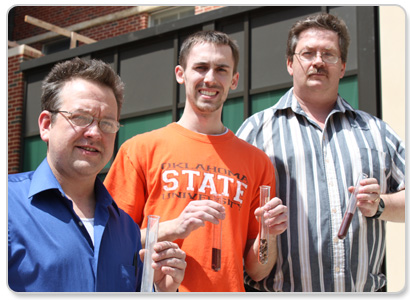OSU researchers develop energy-efficient methods to reclaim wasted iron
Friday, April 9, 2010
(Stillwater, OK April 9, 2010) -- Researchers at Oklahoma State University have
developed an energy-efficient way to extract iron from the more than 100 million tons
of iron ore that are annually wasted in steel mills worldwide. Their methods can also
be used to retrieve iron from several additional waste sources, and are readily adaptable
to large-scale operations, according to OSU chemistry professor Allen Apblett.
“Wasted iron ore alone accounts for 10 percent of the total amount of iron that is
annually processed in steel mills, so the potential global market is significant,
and the processes we use are much more energy-efficient,” said Apblett, who has developed
the extraction procedures in partnership with fellow chemists Kevin Barber and Daniel
Hoel at OSU.
Their research could help refiners trade high cost, energy-eating blast furnaces
for chemical processes at much lower temperatures to remove the iron from the ore.
Apblett calls the alternate processes “green” because they meet one of the key principles
of green science and technology, which is to produce usable materials from sustainable
sources with minimal environmental impact.
In addition to the wasted iron ore at steel mills, the researchers have used their
methods to extract iron from several waste sources such as spent catalysts, waste
from the iron refining process, red mud from aluminum extraction, and coal mine sludge.
“We were even able to get a good yield of iron from a red soil sample we took from
Payne County,” said Apblett, “The sample contained 22. 7 percent iron oxide and not
only produced iron but the resulting soil turned white, making it valuable for use
in ceramics and other areas.”
All of the processes used by the OSU researchers could be easily converted for use
with large quantities of iron ore and waste materials.
Apblett offers specific details in an on-line research journal article titled “Green
Processing of Iron-Based Materials.” Click here to read the article: http://www.azom.com/Details.asp?ArticleID=5114

